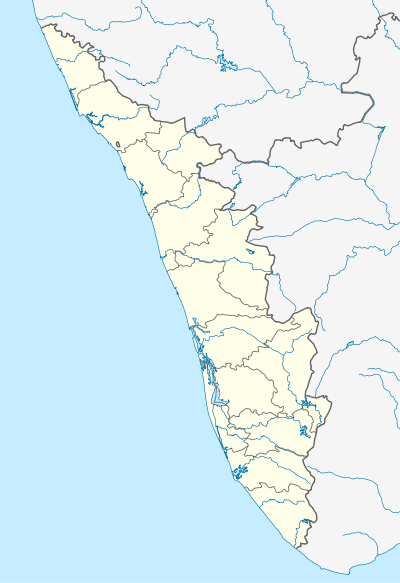Aymanam
| Aymanam അയ്മനം Ayemenem | |
|---|---|
| Village | |
 Aymanam  Aymanam Location in Kerala, India | |
| Coordinates: 9°37′29″N 76°29′06″E / 9.6246600°N 76.4851070°ECoordinates: 9°37′29″N 76°29′06″E / 9.6246600°N 76.4851070°E | |
| Country |
|
| State | Kerala |
| District | Kottayam |
| Area | |
| • Total | 30 km2 (10 sq mi) |
| Population | |
| • Total | 35,562 |
| • Density | 1,200/km2 (3,100/sq mi) |
| Languages | |
| • Official | Malayalam, English |
| Time zone | IST (UTC+5:30) |
| PIN | 686015 |
| Vehicle registration | KL-5 |
| Kottayam | Olassa, Kottayam |
| Climate | tropical (Köppen) |
Aymanam is a village in the Kottayam District of Kerala, India, and the setting for Arundhati Roy's 1997 novel, The God of Small Things. Aymanam is about 4 km from the railway station in Kottayam along the road to Parippu, and 85 km from the Cochin International Airport.
Geography
Ay means "five" in Tamil and Manam means "estate" in Malayalam and Tamil. So Aymanam means "five estates", which, according to tradition, were Vattakkadu, Thuruthikkadu, Vallyakadu, Moolakkadu and Mekkadu. They survive today only as "snake groves", where fertility idols, in the form of snakes, were worshiped under the sacred Banyan tree, together with rice paddies during times of harvest, coconut trees during the festival of Raksha Bandhan, and bulls during the festival of Pongal.
Lake Vembanad lies to the west of the village, near Kumarakom, with the River Meenachil providing its water supply, which often floods from June to August due to regular monsoons. Consequently, two-thirds of the village are paddy fields.
The borders of the village are mostly delineated by rivers or canals, and include the villages of Arpookara, Kumara Nallooru, Thiruvarpu and Kumarakom, and the municipality of Kottayam.
Paddy fields
Two-thirds of Aymanam are paddy fields (i.e. puncha padams), which lie two meters below sea level, with extensive areas extending to Lake Vembanad. The eleven paddy fields are Eraweesvarm, Palliar, Kallumkathra, Puthenkary, Koduvathara, Thollayiram, Ollokkary, Thattarkandam, Menonkary, Pullanapally and Vattakayal.
Traditionally these fields were cropped annually. Following the monsoon in June and July, an outer mud wall was built around each field, and water pumped out in preparation for planting, which took about a month. August–September to January–February was the growing season, after which the crop was harvested. During the dry season in March, April and May, these fields were grazed by cattle and ducks. With the monsoon in June and July, the mud walls were washed away by the flooding rains.
In 1970 the Thollayram paddy field was established with permanent walls, which enabled double cropping and consequent increase in yield. The widespread adoption of this innovation meant that there was nowhere for flood water to escape. Existing small canals could not cope, so the outer walls were washed away by the flooding monsoon rains along with their crops. Many farmers constructed outer walls to face the floods, but only some were effective.
Now almost all fields are protected by permanent outer walls, to the detriment of the local ecology. The Thanneer Mukham wall which forms a salt water barrier across Lake Vembanad, has change its water currents. Now, the mud and waste carried by the rivers into the Lake are not washed out to sea, but settle in the lake, damaging local fish habitats.
Temples and churches
The Sree Narasimha Swamy Temple is located in the heart of Aymanam, while the Pandavam Sree Darmashasta Temple is famed for its murals and the Parippu Sree Mahadeva Temple honors the Lord Shiva.
Historic churches include the St. George chapel of the Jacobite Syrian Christian Church and St.Mark's chapel of the Church of South India.
Popular culture
Arundhati Roy's Booker prize-winning novel The God of Small Things was set at Aymanam, which is spelt "Ayemenem" in this descriptive excerpt:
| “ | May in Ayemenem is a hot, brooding month. The days are long and humid. The river shrinks and black crows gorge on bright mangoes in still, dustgreen trees. Red bananas ripen. Jackfruits burst. Dissolute bluebottles hum vacuously in the fruity air. Then they stun themselves against clear windowpanes and die, fatly baffled in the sun.
The nights are clear, but suffused with sloth and sullen expectation. But by early June the southwest monsoon breaks and there are three months of wind and water with short spells of sharp, glittering sunshine that thrilled children snatch to play with. The countryside turns an immodest green. Boundaries blur as tapioca fences take root and bloom. Brick walls turn mossgreen. Pepper vines snake up electric poles. Wild creepers burst through laterite banks and spill across the flooded roads. Boats ply in the bazaars. And small fish appear in the puddles that fill the PWD potholes on the highways. |
” |
Residents
- Chirattamon Moose - Ayurvedic medical practitioner.
- John Kollenkeril - Identified the site for the Idukki Dam and potential for power generation.
- John Joseph Pannackal - National body builder.
- K. Krishna Kaimal - Actor noted for role in Pattiyude Divasam.
- Ajay Kumar (aka Guinness Pakru) - Malayalam comedy actor.
- N.N. Pillai - Drama and cinema artist.
- Vijayaraghavan (actor) - Malayalam movie actor.
- Mary Poonen Lukose - Surgeon General of India and state legislator of Travancore.
- Eira Margaret Dalton - Medical missionary and writer.